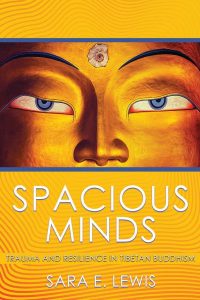Tuesday
UncategorizedSpacious Minds by Sara E. Lewis
Review by Shastri Steve Gleich
Have you ever wondered what it would be like to grow up and live in a Buddhist culture? Would you view the truths of the dharma as common sense? One would be indeed fortunate to be part of a culture in which connecting to “big mind”, thinking of others before self, welcoming difficulty, having gratitude for your circumstances and celebrating the chance to burn through bad karma would come readily to mind. Such elements of dharma would be part of everyday conversation. These elements, these beliefs, sayings, bits of ordinary wisdom would be “in the air”, “in the water” and in the bones.
Dr. Sara Lewis wondered the same things. And, as a psychological anthropologist and new Shambhalian, she found many threads of her professional training and personal interests coming together. She decided to study the Tibetan exile community in Dharamsala, India. She wanted to understand how they coped with dislocation, loss and trauma. She lived among this community in Dharamsala for over one year. Making friends and getting to know the community.
A rich tapestry of stories illustrate life in this community in general and in relation to the focus of her study. Examples: Ani Dawa, the 71 year old nun with mental illness who learned that focusing on oneself brings misery whereas praying for others with similar problems brings happiness; the neighbours who teased her about her style of dress as she joined them for morning prostrations; her Tibetan research assistant who advised her against enrolling in a philosophy course at the monastery, because “Sara-la, you already do too much thinking! You cannot study debate philosophy. You will become ill.” Such ordinary interactions highlight the meeting of different cultures.
In this book, she reports on the results of this in-depth clinical anthropological study of that community. Her study included learning Tibetan, living in the community for over one year and interviewing 80 individuals of all ages about how they coped with difficulty, stress and trauma. Some instances of traumatic stress were extreme. As a clinician and student of culture, she wanted to learn how they regarded these experiences.
Dr. Lewis, who served on the Interim Board of Shambhala recently and holds a faculty position at Naropa University, has already published some of the results of this project in peer reviewed anthropology journals. Now comes this book, a full description of the project and very readable portrait of this unique exile community, gained through formal interviews and day-to-day contacts with neighbours and friends.
Her results are not simple or one-dimensional. She works from a point of view of “multiple truths happening simultaneously”, as she said in an interview with this writer for this review. She also said that her project in Dharamsala found support for the Tibetan Buddhist view of adversity:
[What] I found really interesting about the Buddhist approach, was that resilience is really not the absence of suffering; it is not the opposite of suffering, nor is it the absence of distress in some way. And in fact, for the Tibetan Buddhist approach in particular, just this idea that basic goodness can be found even within the heights of distress and the heights of trauma both on the individual level and the social level and the political level was a very captivating and interesting idea. And still to this day I feel very interested in how it could be that distress and suffering and turmoil could actually be something that enriches our life – and in this idea of bringing suffering to the path. I felt very interested in discovering how this idea could be, not just something from a twelfth century Lojong text but something that ordinary people are living.
So this book, well-written, using very little social science jargon, and gives a vivid, nuanced and rich view of the Tibetan exile community in Dharamsala. She tells stories of the people she studied, and others who became friends. She even includes some anecdotes in which she takes some teasing from Tibetans about some of her western habits and beliefs. She looks into the political implications of the Tibetan approach to coping with adversity. And compares that approach to trauma and treatment to our western biomedical diagnostic and therapeutic methods.
In sum I recommend this book highly – to gain perspective on how ordinary wisdom can be thoroughly woven into a culture, even in exile and even under duress. This study is also provocative for us Shambhalians who are wrestling with questions of how dharma practice can address adversity, including post-traumatic symptoms. The author also notes how victim identity and theories of structural inequality appear to clash with these Tibetan Buddhist cultural values. Don’t expect simple or reductionist answers. But this book enquires deeply into the ways that one culture, infused with Buddhist teaching addresses the difficulties that this lifetime brings. A very interesting read, very sympathetic to members of the Tibetan diaspora, and to the ways that culture-based ideas and practices are interacting, if not colliding, in this time of global communication and exchange.
Want to hear Sara talk about her book? Find her discussion on Shambhala Online here.
You can find Spacious Minds: Trauma and Resilience in Tibetan Buddhism from Cornell University Press here.
 Shastri Steve Gleich feels very fortunate to have received teachings from Chogyam Trungpa Rinpoche and Sakyong Mipham Rinpoche and their senior students and to have been in the Shambhala Buddhist world since 1982. He is now retired from 30+ years career in psychology and mental health and 10+ years career as woodworker. He has been married to Lilly for 38 years, and they are now living in Tatamagouche, Nova Scotia. He continues to volunteer with Dorje Denma Ling, Tatamagouche Shambhala Meditation Group, Dorje Kasung Land Group, and the local food bank.
Shastri Steve Gleich feels very fortunate to have received teachings from Chogyam Trungpa Rinpoche and Sakyong Mipham Rinpoche and their senior students and to have been in the Shambhala Buddhist world since 1982. He is now retired from 30+ years career in psychology and mental health and 10+ years career as woodworker. He has been married to Lilly for 38 years, and they are now living in Tatamagouche, Nova Scotia. He continues to volunteer with Dorje Denma Ling, Tatamagouche Shambhala Meditation Group, Dorje Kasung Land Group, and the local food bank.





